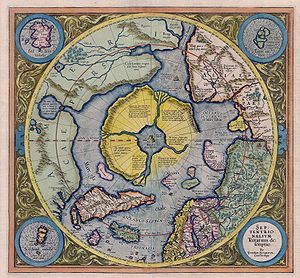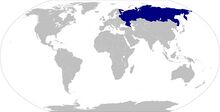Hyperborean Code: Difference between revisions
No edit summary |
|||
| (14 intermediate revisions by the same user not shown) | |||
| Line 1: | Line 1: | ||
{{Construction}} | {{Construction}} | ||
{{Infobox language | |||
|image = Mercator Septentrionalium Terrarum descriptio.jpg | |||
|imagesize = 300px | |||
|imagecaption = An arctic continent on the [[w:Gerardus Mercator|Gerardus Mercator]] map of 1595 | |||
|name = Hyperborean Code | |||
|altname = Athlantl | |||
|nativename = Adļandļ | |||
|pronunciation = ət͡ɬˀənt͡ɬ | |||
|setting = Siberia (?) | |||
|speakers = - | |||
|date = 2024 | |||
|created = {{gcl|c.|circa}} 25,000-12,000 BP | |||
|familycolor = [[Pangaean Code]] | |||
|fam2 = [[Diluvian Code]] | |||
|ancestor = Paleolithic Code | |||
|creator = Veno | |||
|script1 = Latn | |||
|map = Hyperborean.jpg | |||
|mapcaption = Map of areas where the Hyperborean Code is believed to have once been spoken | |||
|notice=IPA | |||
}} | |||
'''Hyperborean''', (Latin Alphabet: Adļandļ, pronounced [ət͡ɬˀənt͡ɬ]) is a [[Philosophical language|philosophical]] [[ab interiori language]] of the [[w:mesolithic|Mesolithic]] that consists on a scheme of templates through [[w:Polysynthesis|polysynthesis]]. Its creator, [[User:Veno|Veno]], named the [[Paleolithic Code]] as such due the similarity with the Athabaskan, Salishan, Yeniseian, Northwest-Caucasian, and other linguistic families mainly from Siberia and North-America. | |||
==Introduction== | ==Introduction== | ||
| Line 63: | Line 84: | ||
--> | --> | ||
Template of 9 positions... | |||
''adļandļ'' /ət͡ɬˀənt͡ɬ/, an adjective describing ''adļandļs'' /ət͡ɬˀənt͡ɬs/ "X that is not a right/property", from ''dļas'' /t͡ɬˀəs/ "obligation/ownership" | |||
''śaškhpáļ'' "I will kill you" | |||
''kʷˀ-n'' "dog" | |||
''kʷˀ-ŋχʲ'' "rain" | |||
''t͡sʲˀ-k'' "stone" | |||
''-χʷˀ-'' "house" | |||
Diluvian ''nacar'' "familiarity, norms, people" > Hyperboran ''nas'' /nˀəs/ "people" | |||
Diluvian ''hecar'' "wind" > Hyperboran ''ngias'' /ŋkʲˀəs/ "wind" | |||
> [adaptation] > ''-gci-'' /kˀt͡sˀʲ/ > [stabilization] > ''ciax'' /t͡sˀʲəks/ "stone" | |||
Diluvian ''da'' "movement" > Hyperboran ''nda'' /ntə/ | |||
nxia /ŋχʲʰəʔ/ "X moves"<br> | |||
nxiap /ŋχʲʰəpˀ/ "a wrappable long material moves"<br> | |||
nxiat /ŋχʲʰətˀ/ "a slender stiff object moves"<br> | |||
nxiakt /ŋχʲʰəkˀtˀ/ "a pasta-like material moves"<br> | |||
nxial /ŋχʲʰəlˀ/ "a flexible material moves"<br> | |||
tʲ + s = tʃ | |||
t + s = ts | |||
tʷ + s = tʂ | |||
Fusions | |||
j + ɬ = ʎ | |||
Reductions | |||
t͡s - s = θ | |||
''vaļ'' | ''vaļ'' | ||
švadļ | švadļ | ||
''śkwądls''<br> | |||
ʂ-kʷˀ-(∅)-ə̃-(∅)-tɬ-s | |||
á progressive | |||
à past inconclusive | |||
ā̀ past conclusive | |||
∅ present iconclusive | |||
á future inconclusive ā̀ | |||
ā́ future conclusive | |||
/aː/ /áː/ /àː/ /âː//ãː/ /ã́ː/ /ã̀ː/ /ã̂ː//aːʔ/ /áːʔ/ /àːʔ/ /âːʔ//ãːʔ/ /ã́ːʔ/ /ã̀ːʔ/ /ã̂ːʔ/ | |||
ļ + s = ļ | ļ + s = ļ | ||
ś /ʂ/ [1s] š /ʃ/ [2s] s /s/ [3] | |||
''śqua'' "you speak" | |||
There are 4 classifiers (*∅, *d, *ļ, and *dļ), but two of their forms require the generic subject *s [-4] in order to represent the 6 voices: | |||
''qua'' /qˀʷəˀ/ "he/she/it experiences the saying" [experimental voice] | |||
''quad'' [passive voice] | |||
''squad'' [passive-obligative voice] | |||
''quaļ'' [medio-passive voice] | |||
''squaļ'' [active voice] | |||
''quadļ'' [active-obligative voice] | |||
{| class="wikitable" style="width:100%" | |||
! colspan="9" align="center"| Conjunct | |||
|- | |||
| align="center"| -4 | |||
| align="center"| -3 | |||
| align="center"| -2 | |||
| align="center"| -1 | |||
| align="center"| 0 | |||
| align="center"| 1 | |||
| align="center"| 2 | |||
| align="center"| 3 | |||
| align="center"| 4 | |||
|- | |||
| align="center"| Subject | |||
| align="center"| Biradical Root | |||
| align="center"| ? | |||
| align="center"| Animacy | |||
| align="center"| Tense / Aspect / Number | |||
| align="center"| Voice / Subject / Negation | |||
| align="center"| Subject | |||
| align="center"| Biradical Root | |||
| align="center"| Function | |||
|} | |||
==Syntax== | ==Syntax== | ||
Latest revision as of 17:54, 30 December 2024
This article is a construction site. This project is currently undergoing significant construction and/or revamp. By all means, take a look around, thank you. |
| Hyperborean Code | |
|---|---|
| Athlantl | |
| Adļandļ | |
 An arctic continent on the Gerardus Mercator map of 1595 | |
| Pronunciation | ət͡ɬˀənt͡ɬ |
| Created by | Veno |
| Date | c. 25,000-12,000 BP |
| Setting | Siberia (?) |
| Native speakers | - (2024) |
Pangaean Code
| |
Early form | Paleolithic Code
|
Map of areas where the Hyperborean Code is believed to have once been spoken | |
Hyperborean, (Latin Alphabet: Adļandļ, pronounced [ət͡ɬˀənt͡ɬ]) is a philosophical ab interiori language of the Mesolithic that consists on a scheme of templates through polysynthesis. Its creator, Veno, named the Paleolithic Code as such due the similarity with the Athabaskan, Salishan, Yeniseian, Northwest-Caucasian, and other linguistic families mainly from Siberia and North-America.
Introduction
Phonology
Orthography
Consonants
Vowels
Prosody
Stress
Intonation
Phonotactics
Morphophonology
Morphology
Template of 9 positions...
adļandļ /ət͡ɬˀənt͡ɬ/, an adjective describing adļandļs /ət͡ɬˀənt͡ɬs/ "X that is not a right/property", from dļas /t͡ɬˀəs/ "obligation/ownership"
śaškhpáļ "I will kill you"
kʷˀ-n "dog" kʷˀ-ŋχʲ "rain" t͡sʲˀ-k "stone" -χʷˀ- "house"
Diluvian nacar "familiarity, norms, people" > Hyperboran nas /nˀəs/ "people"
Diluvian hecar "wind" > Hyperboran ngias /ŋkʲˀəs/ "wind"
> [adaptation] > -gci- /kˀt͡sˀʲ/ > [stabilization] > ciax /t͡sˀʲəks/ "stone"
Diluvian da "movement" > Hyperboran nda /ntə/
nxia /ŋχʲʰəʔ/ "X moves"
nxiap /ŋχʲʰəpˀ/ "a wrappable long material moves"
nxiat /ŋχʲʰətˀ/ "a slender stiff object moves"
nxiakt /ŋχʲʰəkˀtˀ/ "a pasta-like material moves"
nxial /ŋχʲʰəlˀ/ "a flexible material moves"
tʲ + s = tʃ t + s = ts tʷ + s = tʂ Fusions j + ɬ = ʎ Reductions t͡s - s = θ
vaļ
švadļ
śkwądls
ʂ-kʷˀ-(∅)-ə̃-(∅)-tɬ-s
á progressive à past inconclusive ā̀ past conclusive ∅ present iconclusive á future inconclusive ā̀ ā́ future conclusive
/aː/ /áː/ /àː/ /âː//ãː/ /ã́ː/ /ã̀ː/ /ã̂ː//aːʔ/ /áːʔ/ /àːʔ/ /âːʔ//ãːʔ/ /ã́ːʔ/ /ã̀ːʔ/ /ã̂ːʔ/
ļ + s = ļ
ś /ʂ/ [1s] š /ʃ/ [2s] s /s/ [3]
śqua "you speak"
There are 4 classifiers (*∅, *d, *ļ, and *dļ), but two of their forms require the generic subject *s [-4] in order to represent the 6 voices: qua /qˀʷəˀ/ "he/she/it experiences the saying" [experimental voice] quad [passive voice] squad [passive-obligative voice] quaļ [medio-passive voice] squaļ [active voice] quadļ [active-obligative voice]
| Conjunct | ||||||||
|---|---|---|---|---|---|---|---|---|
| -4 | -3 | -2 | -1 | 0 | 1 | 2 | 3 | 4 |
| Subject | Biradical Root | ? | Animacy | Tense / Aspect / Number | Voice / Subject / Negation | Subject | Biradical Root | Function |

